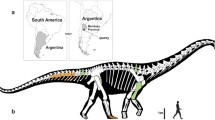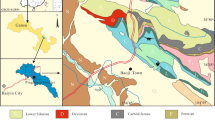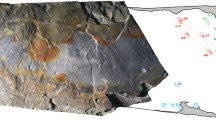Abstract
This article considers the unusual Macropodosaurus gravis tracks from the Early Cretaceous (Albian) locality of Shirkent-1 (Tajikistan). The trackmaker was bipedal and plantigrade. Through a comparison of Macropodosaurus tracks with those of other dinosaurs and by a juxtaposition of track morphology and pes skeletal morphology, it is argued that they belong to an aberrant group of theropods, the segnosaurs. Data on the stratigraphic and geographical distribution of segnosaur tracks are presented. Aspects of functional morphology of the hind limbs are analyzed, as well as the locomotory mode and the possible lifestyle of this group of dinosaurs. Segnosaurs were most likely herbivorous; their possible ecological counterparts are giant ground sloths. The ancestors of segnosaurs were probably facultatively digitigrade and underwent a short-term stage as arboreal, climbing forms, and then reversed to a purely terrestrial lifestyle. Return to plantigrade locomotion in segnosaurs apparently required increased area of support during the slow obligate bipedal locomotion of these heavy theropods.






















Similar content being viewed by others
REFERENCES
Abel, O., Grundzüge der Paläobiologie der Wirbeltiere. Stuttgart: E. Schweizerbart, 1911.
Abel, O., Vorzeitliche Lebensspuren. Jena: G. Fischer, 1935.
Alvarenga, H.M.F. and Höfling, E., Systematic revision of the Phorusrhacidae (Aves: Ralliformes), Pap. Avulsos Dep. Zool., Secr. Agric., Ind. Comer. (Sao Paulo), 2003, vol. 43, no. 4, pp. 55–91.
Ammaniyazov, K.N., Dinosaurs, the old acquaintances, Nauka v SSSR, 1986, no. 1, pp. 97–108.
Andors, A., Reappraisal of the Eocene groundbird Diatryma (Aves: Anserimorphae), Nat. Hist. Mus. Los Angeles Co., Set Ser., 1992, vol. 36, pp. 109–125.
Aramayo, S.A., de Bianco, T.M., Bastianelli, N.V. and Melchor, R.N. Pehuen Co: Updated taxonomic review of a late Pleistocene ichnological site in Argentina, Palaeogeogr., Palaeoclimatol., Palaeoecol., 2015, vol. 439, pp. 144–165.
Aramayo, S.A., Neogene vertebrate palaeoichnology of the North Atlantic coast of the Río Negro province, Argentina, Arq. Mus. Nac. (Rio de Janeiro), 2007, vol. 65, no. 4, pp. 573–584.
Baratov, R.B. and Novikov, V.P., Tajikistan’s Wonder of Stone, Dushanbe: Irfon, 1988.
Barsbold, R., Predatory dinosaurs from the Cretacous of Mongolia, Tr. Sovm. Sov.-Mong. Paleont. Eksp., 1983, vol. 19, pp. 1–119.
Barrett, P.M., The affinities of the enigmatic dinosaur Eshanosaurus deguchiianus from the Early Jurassic of Yunnan province, People’s Republic of China, Palaeontology, 2009, vol. 52, no. 4, pp. 681–688.
Barsbold, R. and Perle, A., Segnosauria, a new infraorder of carnivorous dinosaurs, Acta Palaeontol. Pol., 1980, vol. 25, no. 2, pp. 187–195.
Barsbold, R., New data on the therezinosaur (Therizinosauridae, Theropoda), Tr. Sovm. Sov.-Mong. Paleont. Eksp., 1976, vol. 3, pp. 76–91.
Bordy, E.M., Bumby, A.J., Catuneanu, O. and Eriksson, P.G., Advanced Early Jurassic termite (Insecta: Isoptera) nests: evidence from the Clarens formation in the Tuli Basin, Southern Africa, Palaios, 2004, vol. 19, no. 1, pp. 68–78.
Bordy, E.M., Bumby, A.J., Catuneanu, O. and Eriksson, P.G., Possible trace fossils of putative termite origin in the Lower Jurassic (Karoo Supergroup) of South Africa and Lesotho, S. Afr. J. Sci., 2009, vol. 105, nos. 9–10, pp. 356–362.
Casamiquela, R.M., El bipedismo de los megaterioideos. Estudio de pisadas fósiles en la Formacion Río Negro típica, Ameghiniana, 1974, vol. 11, no. 3, pp. 249–282.
Chatterjee, S., Protoavis and the early evolution of birds, Palaeontographica. Abt. A., 1999, vol. 254, Lf. 1–3, pp. 1–100.
Clark, J.M., Maryanska, T. and Barsbold, R., Therizinosauroidea, in The Dinosauria, 2nd ed., Berkeley, CA: University of California Press, 2004, pp. 151–164.
Colbert, E.H., The Triassic dinosaur Coelophysis, Mus. North. Arizona Bull., 1989, vol. 57, pp. 1–160.
Conti, M.A., Morsilli, M., Nicosia, U., Sacchi, E., Savino, V., Wagensomer, A. di Maggio, L., and Gianolla, P. Jurassic dinosaur footprints from Southern Italy: footprints as indicators of constraints in paleogeographic interpretation, Palaios, 2005, vol. 20, no. 6, pp. 534–550.
Cooper, M.R., The prosauropod dinosaur Massospondylus carinatus Owen from Zimbabwe: its biology, mode of life and phylogenetic significance, Occas. Pap. Natl. Mus. South. Rhod., Ser. B, 1981, vol. 6, no. 10, pp. 689–840.
Dececchi, T.A., Mloszewska, A.M. and Holtz, T.R., Jr., Dececchi, T.A., Mloszewska, A.M. and Holtz, T.R., Dececchi, T.A., Mloszewska, A.M. and Holtz, T.R., The fast and the frugal: Divergent locomotory strategies drive limb lengthening in theropod dinosaurs, PLoS One, 2020, vol. 15, no. 5, e0223698.
Dong, Z., Cretaceous dinosaurs of Huanan (South China), Mesozoic and Cenozoic Redbeds in Southern China, Zheng et al., Beijing: Science Press. 1979, pp. 342–350.
Dzhalilov, M.R. and Novikov, V.P., Fossil dinosaur tracks in Tajikistan, in Sledy zhiznedeyatel’nosti drevnikh organizmov (Traces of Fossil Organisms), Vialov, O.S. and Fedonkin, M.A., Eds., 1993, pp. 47–65.
Fiorillo, A.R. and Adams, Th.L., A therizinosaur track from the Lower Cantwell Formation (Upper Cretaceous) of Denali National Park, Alaska, Palaios, 2012, vol. 27, no. 5/6, pp. 395–400.
Fiorillo, A.R., McCarthy, P.J, Kobayashi, Y., Tomsich, C.S., Tykoski, R.S., Lee, Y-N., Tanaka, T., and Noto, Ch.R., An unusual association of hadrosaur and therizinosaur tracks within Late Cretaceous rocks of Denali National Park, Alaska, Sci. Rep., 2018, vol. 8, no. 1, art. ID 11706.
Formozov, A.N., Sputnik sledopyta (Tracker’s Guide), Moscow: Mosk. Gos. Univ., 1989.
Gianechini, F.A., Ercoli, M.D. and Diaz-Martinez, I., Differential locomotor and predatory strategies of Gondwanan and derived Laurasian dromaeosaurids (Dinosauria, Theropoda, Paraves): Inferences from morphometric and comparative anatomical studies, J. Anat., 2020, vol. 236, no. 5, pp. 772–797.
Gierlinski, G.D. and Lockley, M.G., A trackmaker for Saurexallopus: ichnological evidence for oviraptorosaurian tracks from the Upper Cretaceous of Western North America, At the top of the Grand Staircase: The Late Cretaceous of Southern Utah, Gierlinski, G.D. and Lockley, M.G., Eds., Bloomigton: Indiana Univ. Press, 2013a, pp. 526–529.
Gierlinski, G.D. and Lockley, M.G., First Report of Probable Therizinosaur (cf. Macropodosaurus) Tracks from North America, with Notes on the Neglected Vertebrate Ichnofauna of the Ferron Sandstone (Late Cretaceous) of Central Utah, At the Top of the Grand Staircase: The Late Cretaceous of Southern Utah, Bloomigton: Indiana Univ. Press, 2013b, pp. 530–535.
Gierliński, G.D. and Niedzwiedzki, G., New saurischian dinosaur footprints from the Lower Jurassic of Poland, Geol. Quart., 2005, vol. 49, no. 1, pp. 99–104.
Gierliński, G.D., New dinosaur footprints from the Upper Cretaceous of Poland in the light of paleogeographic context, Ichnos, 2015, vol. 22, nos. 3–4, pp. 220–226.
Gierliński, G.D., Preliminary report on new dinosaur tracksites in the Triassic, Jurassic and Cretaceous of Poland, Actas de Las IV Jornadas Internacionales sobre Paleontologia de Dinosaurios y su Entorno. Salas de los Infantes, Burgos, 2009, pp. 75–90.
Gillette, D.D., Therizinosaur. Mystery of sickle-claw dinosaur, in Plateau: The Land and People of the Colorado Plateau, Flagstaff, AZ: Mus. North. Ariz., 2007. Vol. 4, no. 2. P. 1–72.
Gilmore, C.W., Osteology of the carnivorous Dinosauria in the United States National Museum, with special reference to the genera Antrodemus (Allosaurus) and Ceratosaurus, Bull. U.S. Nat. Mus., 1920, vol. 110, pp. 1–154.
Hasiotis, S.T. and Dubiel, R.F., Termite (Insecta: Isoptera) nest ichnofossils from the Triassic Chinle Formation, Petrified Forest National Park, Arizona, Ichnos, 1995, vol. 4, no. 2, pp. 119–130.
Haubold, H., Ichnia Amphibiorum et Reptiliorum Fossilium, Handbuch der Palaeoherpetologie. Stuttgart: Gustav Fischer Verlag, 1971, vol. 18.
Hedrick, B.P., Zanno, L.E., Wolfe, D.G. and Dodson, P., The slothful claw: osteology and taphonomy of Nothronychus mckinleyi and N. graffami (Dinosauria: Theropoda) and anatomical considerations for derived therizinosaurids, PLoS One, 2015. V.10, no. 6. e129449, pp. 1–49.
Holtz, T.R., The arctometatarsalian pes, an unusual structure of the metatarsus of Cretaceous Theropoda (Dinosauria: Saurischia), J. Vertebr. Paleontol., 1994, vol. 14, no. 4. pp. 480–519.
Kim, J.Y. and Lockley, M.G., Review of Dinosaur Tail Traces, Ichnos, 2013, vol. 20, no. 3, pp. 129–141.
Kim, J.Y., Lockley, M.G., Kim, K.S., Seo, S.J. and Lim, J.D., Enigmatic giant pterosaur tracks and associated ichnofauna from the Cretaceous of Korea: implication for the bipedal locomotion of pterosaurs, Ichnos, 2012, vol. 19, nos. 1–2, pp. 50–65.
Kim, K.S., Lockley, M.G., Lim, J.D., Bae, S.M. and Romilio, A., Trackway evidence for large bipedal crocodylomorphs from the Cretaceous of Korea, Sci. Rep., 2020, vol. 10, no. 8680, pp. 1–13.
Kuban, G.J., Elongate dinosaur tracks, in Dinosaur Tracks and Traces, Kuban, G.J., Ed., Cambridge: Cambridge Univ. Press, pp. 57–71.
Kurzanov, S.M., Avimimids and the origin of birds, Tr. Sovm. Sov.-Mong. Paleont. Eksp., 1987, vol. 31.
Lautenschlager, S., Cranial myology and bite force performance of Erlikosaurus andrewsi: a novel approach for digital muscle reconstructions, J. Anat., 2013, vol. 222, no. 2, pp. 260–272.
Lautenschlager, S., Functional niche partitioning in Therizinosauria provides new insights into the evolution of theropod herbivory, Palaeontology, 2017, vol. 60, no. 3, pp. 375–387.
Li, D.-G., You, H.-L. and Zhang, J.-P., A new specimen of Suzhousaurus megatherioides (Dinosauria: Therizinosauroidea) from the Early Cretaceous of northwestern China, Can. J. Earth Sci., 2008, vol. 45, no. 7, pp. 769–779.
Maleev, E.A., Giant carnosaurs of the family Tyrannosauridae, Fauna i biostratigrafiya mezozoya i kainozoya Mongolii (Fauna and Biostratigraphy of the Mesozoic and Cenozoic of Mongolia), Tr. Sovm. Sov.-Mong. Paleont. Exp., vol. 1, Moscow: Nauka, 1974, pp. 132–191.
Masrour, M., Lkebir, N. and Perez-Lorente, F., Anza palaeoichnological site. Late Cretaceous. Morocco. Part II. Problems of large dinosaur trackways and the first African Macropodosaurus trackway, J. Afr. Earth Sci., 2017, vol. 134, pp. 776–793.
McCrea, R.T., Locley, M.G. and Meyer, C.A., Global distribution of purported ankylosaur track occurrences, in The Armored Dinosaurs, Carpenter, K., Ed., Bloomington: Indiana University Press, 2001, pp. 413–454.
McDonald, H.G., Biomechanical inferences of locomotion in ground sloths: integrating morphological and track data, New Mex. Mus. Nat. Hist. Sci. Bull., 2007, no. 42, pp. 201–208.
McNeill Alexander, R., Dynamics of Dinosaurs and Other Extinct Giants, New York: Columbia Univ. Press, 1989.
Nesov, L.A., Dinozavry Severnoi Evrazii: novye dannye o sostave kompleksov, ekologii i paleobiogeografii (Dinosaurs of Northern Eurasia: New Data on the Composition of Complexes, Ecology and Paleobiogeography), St. Petersburg: S.-Peterb. Gos. Univ., 1995.
Novikov, V.P. and Dzhalilov, M.R., Sedimentological interpretation of the dinosaur track sites in Tajikistan, Trudy XXX Sessii Vsesoyuznogo paleontologicheskogo obshchestva i VII sessii Ukrainskogo paleontologicheskogo obshchestva “Sledy zhiznedeyatel’nosti i dinamika sredy v drevnikh biotopakh” (Proc. XXX Session of the All-Union Paleontological Society and VII Session of the Ukrainian Paleontological Society “Trace Fossils and Environmental Dynamics in Ancient Biotopes”), Bogdanova, T.N., Khozatskii, L.I., and Ishchenko, A.A., Eds., Kiev: Naukova Dumka, 1988, pp. 45–57.
Novikov, V.P., The Shirkent-1 dinosaur track site, Iskopaemye sledy zhizni na territorii Srednei Azii. (Putevoditel’ ekskursii Vsesoyuznogo seminara) (Fossil Traces of Central Asia (Field Trip Guide for the All-Union Workshop)), Dzhalilov, M.P., and Novikov, V.P., Eds., Dushanbe: Donish, 1987, pp. 15–17.
Ostrom, J.H., Osteology of Deinonychus antirrhopus, an unusual theropod from the Lower Cretaceous of Montana, Bull. Peabody Mus. Nat. Hist., 1969, no. 30, pp. 1–165.
Ostrom, J.H., The osteology of Compsognathus longipes Wagner, Zitteliana, 1978, vol. 4, pp. 73–118.
Pashchenko, D.I., A new interpretation of the crocodile forelimb morphological features as adaptation to parasagittal quadrupedal locomotion on the ground, Dokl. Biol. Sci., 2018, vol. 483, no. 5, pp. 584–587.
Paul, G.S., The segnosaurian dinosaurs: relics of the prosauropod-ornithischian transition, J. Vertebr. Paleontol., 1984, vol. 4, no. 4, pp. 507–515.
Perle, A., A new segnosaurid from the Upper Cretaceous of Mongolia, Tr. Sovm. Sov.-Mong. Paleont. Eksp., 1981a, vol. 15, pp. 50–59.
Perle, A., On the discovery of the hindlimb of Therizinosaurus sp. from the Upper Cretaceous of Mongolia, Probl. Geol. Mongol., 1981b, no. 5, pp. 94–98.
Perle, A., Segnosauridae: a new theropod family from the Late Cretaceous of Mongolia, Tr. Sovm. Sov.-Mong. Paleont. Eksp., 1979, vol. 8, pp. 45–54.
Perle, A., Sravnitel’naya anatomiya dinozavrov—yashcherotazovykh (Comparative Anatomy of Saurischian Dinosaurs). Ulaanbaatar, 2005.
Pu, H.-N., Kobayashi, Y., Lu, J.-C., Xu, L., Wu, Y.-H., Chang, H., Zhang, J.-M., and Jia, S.-H., An unusual basal therizinosaur dinosaur with an ornithischian dental arrangement from Northeastern China, PLoS One, 2013, vol. 8, no. 5, e63423, pp. 1–19.
Rhodes, M.M., Henderson, D.M. and Currie, P.J., Maniraptoran pelvic musculature highlights evolutionary patterns in theropod locomotion on the line to birds, PeerJ., 2021, vol. 9, e10855, pp. 1–57.
Romer, A.S., Osteology of the Reptilia, Chicago: Univ. Chicago Press. 1956.
Rozhdestvenskii, A.K. and Khozatskii, L.I., Late Mesozoic terrestrial vertebrates of the Asian part of the USSR, Stratigrafiya i paleontologiya mezozoiskikh i paleogenovykh kontinental’nykh otlozhenii aziatskoi chasti SSSR (Stratigraphy and paleontology of Mesozoic and Paleogene continental deposits of the Asian part of the USSR), Leningrad: Nauka, 1967, pp. 82–92.
Rozhdestvenskii, A.K., On the giant ungual phalanges of the mysterious Mesozoic reptiles, Paleontol. Zh., 1970, no. 1, pp. 131–141.
Russell, D.A. and Dong, Z.-M., The affinities of a new theropod from the Alxa Desert, Inner Mongolia, People’s Republic of China, Can. J. Earth Sci., 1993, vol. 30, nos. 10–11, pp. 2107–2127.
Russell, D.A. and Russell, D.E., Mammal-dinosaur convergence, Natl. Geogr. Res. Explor., 1993, vol. 9, no. 1, pp. 70–79.
Sennikov, A.G., Early thecodonts of Eastern Europe, Tr. Paleontol. Inst., Akad. Nauk SSSR, 1995, vol. 263, pp. 1–141.
Sennikov, A.G., Reading segnosaur tracks, Priroda (Moscow), 2006, no. 5, pp. 58–67.
Sennikov, A.G., The main evolutionary patterns of the development of the locomotor apparatus of archosaurs, Paleontol. Zh., 1989, no. 4, pp. 63–72.
Starck, D., Vergleichende Anatomie der Wirbeltiere, Vol. 2: Das Skeletsystem, Berlin: Springer Verlag, 1979.
Thulborn, R.A., Dinosaur Tracks, London: Chapman and Hall, 1990.
Xu, X., Cheng, Y.-N., Wang, X.-L. and Chang, C.-S., Pygostyle-like structure from Beipiaosaurus (Theropoda, Therizinosauroidea) from the lower Cretaceous Yixian Formation of Liaoning, China, Acta Geol. Sin., 2003, vol. 77, no. 3, pp. 294–298.
Xu, X., Tang, Z.-L. and Wang, X.-L., A therizinosaurid dinosaur with integumentary structures from China, Nature, 1999, vol. 399, no. 6734, pp. 350–354.
Xu, X., Zhao, X. and Clark, J.M., A new therizinosaur from the Lower Jurassic Lower Lufeng Formation of Yunnan, China, J. Vertebr. Paleontol., 2001, vol. 21, no. 3, pp. 477–483.
Zakharov, S.A. and Khakimov, F.Kh., Cenomanian dinosaur tracks in Western Tajikistan, Dokl. Akad. Nauk Tajik. SSR, 1963, vol. 6, no. 9, pp. 25–27.
Zakharov, S.A., On the Cenomanian dinosaur trackmaker of the tracks found in the Shirkent Valley, Paleontologiya Tadzhikistana (Paleontology of Tajikistan), Reiman, V.M., Ed., Dushanbe: Akad. Nauk Taj. SSR, 1964, pp. 31–35.
Zanno, L.E., A taxonomic and phylogenetic re-evaluation of Therizinosauria (Dinosauria: Maniraptora), J. Syst. Palaeontol., 2010a, vol. 8, no. 4, pp. 503–543.
Zanno, L.E., Osteology of Falcarius utahensis: characterizing the anatomy of basal therizinosaurs, Zoological Journal of the Linnean Society, 2010b, vol. 158, no. 1, pp. 196–230.
Zanno, L.E., Gillette, D.D., Albright, L.B. and Titus, A.L., A new North American therizinosaurid and the role of herbivory in “predatory” dinosaur evolution, Proc. R. Soc., B, 2009, vol. 276, no. 1672, pp. 3505–3511.
Zhang, X.-H., Xu, X., Zhao, X.-J., Sereno, P.C., Kuang, X.-W. and Tan, L., A long-necked therizinosauroid dinosaur from the Upper Cretaceous Iren Dabasu Formation of Nei Mongol, People’s Republic of China, Vertebr. PalAsiatica, 2001, vol. 39, no. 4, pp. 282–290.
ACKNOWLEDGMENTS
The author thanks the geologists V.P. Novikov and V.V. Kurbatov for providing photographs of Macropodosaurus tracks and valuable consultations on dinosaur tracks in Central Asia. The author thanks B.P. Hedrick (Department of Cell Biology and Anatomy, School of Medicine, Louisiana State University, Health Sciences Center, New Orleans, United States) for providing photographs of the pelvis of the segnosaur Nothronychus graffami, and A.A. Karhu (Borissiak Paleontological Institute, Russia) for sharing his hypothesis about the arboreal life habits and locomotion of Deinonychus and providing a drawing illustrating this hypothesis, and A.N. Kuznetsov (Borissiak Paleontological Institute) for suggesting to study the orientation of the acetabulum in segnosaurs, and for valuable comments.
Funding
This work was supported by the Russian Foundation for Basic Research grant number 20-04-00070.
Author information
Authors and Affiliations
Corresponding author
Additional information
Translated by D. Ponomarenko
Rights and permissions
About this article
Cite this article
Sennikov, A.G. The Plantigrade Segnosaurians: Sloth Dinosaurs or Bear Dinosaurs?. Paleontol. J. 55, 1158–1185 (2021). https://doi.org/10.1134/S0031030121100087
Received:
Revised:
Accepted:
Published:
Issue Date:
DOI: https://doi.org/10.1134/S0031030121100087




